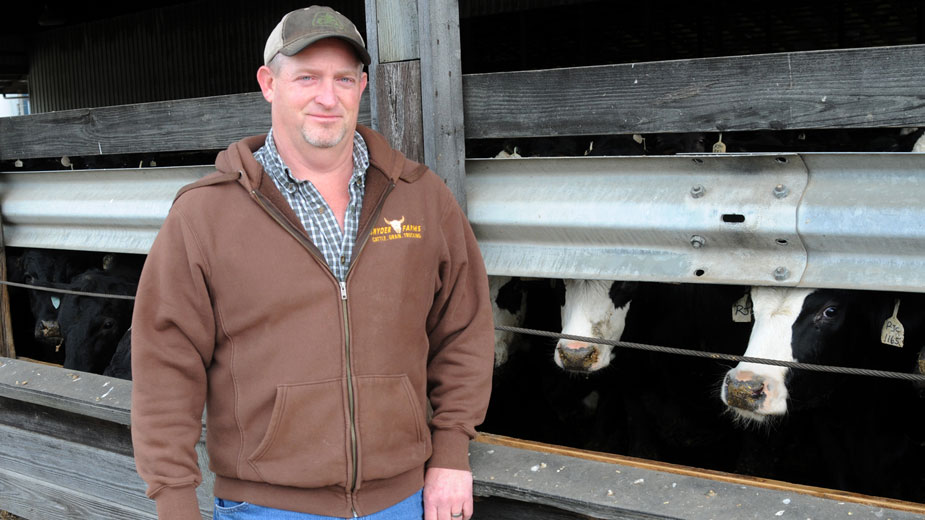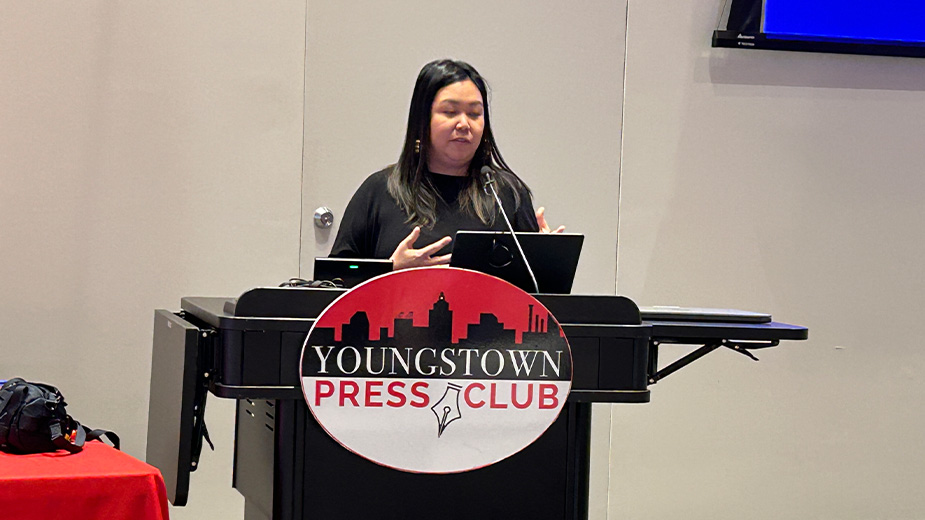Cattle Farmers Wait Out Tough Season
YOUNGSTOWN, Ohio – As with much of the beef raised on pastures in northeastern Ohio and western Pennsylvania, profit margins are lean this season for farmers who say the downturn in grain and soybean prices is having a trickle-down effect on the price of cattle.
“We’re a good 10 to 12 cents off in terms of price,” says Bryan Snyder of Snyder & Son Farms Inc., New Springfield. “It’s almost like the cattle market is following the grain market.”
Snyder says the ongoing trade dispute between the United States and China hasn’t helped matters across the agricultural industry. Yet he acknowledges that his farm expected some market volatility this year as the tariff war between the two countries deepened. Beef, although not directly affected by retaliatory tariffs enacted by China on U.S. imports, is still affected since it is traded as a global commodity.
“We knew before this trade war started that things were going to get worse before they got better,” Snyder says. “It’s really cut into our profits. In the long run, we hope it pans out for everybody.”
While that’s good news for consumers ready to fire up their grills over the summer, it’s bad news for cattle farmers who are struggling to maintain profitability during these difficult times.
“At this point right now, we’re going to be happy if we break even,” Snyder says.
The farm sells Angus cattle to major processors such as Tyson and JBS, Snyder says. These processors then package the products and sell to markets throughout the United States and around the world.
Snyder farms about 1,000 acres and maintains “a couple hundred head” of cattle. About 300 acres at the farm is supplemented by growing soybeans and another 150 acres is dedicated to corn. While the corn market shows signs of improvement, it isn’t enough to offset losses in the beef or soybean sectors.
“In the grand scheme of things, it still hurts,” Snyder says.
As of May 20, live-cattle prices closed at $1.11 per pound, a big retreat from this year’s peak price of $1.30 in March. Still, prices are slightly ahead of where they were in May and June 2018, when the commodity sank to just $1.03 per pound.
However, analysts say these prices are poised to rebound as China moves to import more beef, pork and poultry to replenish its anemic hog market, which has been devastated by swine fever.
Recently, a new trade agreement with Japan eliminated some longstanding restrictions on U.S. beef exports to that country. The agreement allows for all cattle, regardless of age, to enter Japan for the first time since 2003. In December of that year, Japan banned U.S. beef and beef products after it detected a BSE-positive animal in the United States. In 2005, Japan opened access to beef from cattle less than 20 months in age and expanded beef shipments to include those less than 30 months old.
The U.S. Department of Agriculture estimates that this access could boost U.S. beef and beef-product exports by up to $200 million a year.
Nevertheless, beef prices have been sluggish for several years, says Greg Burbick of G. Burbick Farms in Beaver Township. “A couple of years ago, the price of fat cattle was about $2.25 a pound,” he says.
Indeed, just about every sector in agriculture is feeling the brunt of depressed prices, he says. “If you talk with anyone in agriculture, they’ll tell you all of the markets are bad.”
Burbick houses about 50 head of cattle at his farm as well as some hogs. Since he operates his own retail operation from the farm, he’s insulated to an extent from the market prices set on the commodities exchange. “My retail prices are somewhat protected because there’s no middleman,” he says.
Burbick raises cattle on the farm and then transports it to J. Whiting Family Foods Processing in New Wilmington, Pa. There, the beef is processed into ground meat, steaks and cuts and then packaged and sold through Burbick.
“My sales are really steady,” he says. “There are people here who are concerned about what they eat.”
Audrene Burns, owner of Burns Angus Farm in New Wilmington, Pa., says that business is on the upswing for the farm that specializes in grass-fed cattle. “We’re 100% grass fed – no antibiotics, no byproducts and no added hormones,” she says.
The consumer trend toward grass-fed beef developed in earnest earlier this decade, Burns says, noting its well-publicized health benefits as opposed to hormone-injected beef. However, around 2016, more retail stores started to carry imported meats packaged and labeled as grass-fed and grass-finished, which cut into the market share of local farms.
Such packaging was misleading in some cases, Burns says, because it was determined that the beef originated from cattle that were not grass-fed throughout their entire lifespans. And, many of these imported products contained deceptive labels advertising “Product of the U.S.A.,” when in fact the cattle were raised and fed in another country and the meat merely processed in the United States.
“That caused us to change our description on labeling in reference to how we raise our animals,” she says, underscoring the 100% grass-fed distinction.
“We rode it out. We’ve had a lot of people come back to us saying it just wasn’t the same in the retail stores.”
Burns and her husband, John, are first-generation cattle farmers and sell about 80 animals a year, she says. The cattle is pastured on three farms the Burnses own, while two others are rented. Together, the operation consists of nearly 700 acres. The farm also raises fresh lamb for consumption.
“We really have to focus on grass management – making it as clean as possible,” Burns says.
More consumers today are concerned about where and how their beef is raised, Burns says. Often, those who are returning to the region or are relocating to the area have already done their research online as to where to buy fresh, grass-fed meats.
“We’ve had people move to the area. First they talk to their realtor,” she says. “Their second call is to us. It’s really incredible.”
Pictured: With beef prices sinking, Snyder & Son Farms will “be happy if we break even,” says owner Bryan Snyder.
Copyright 2024 The Business Journal, Youngstown, Ohio.



